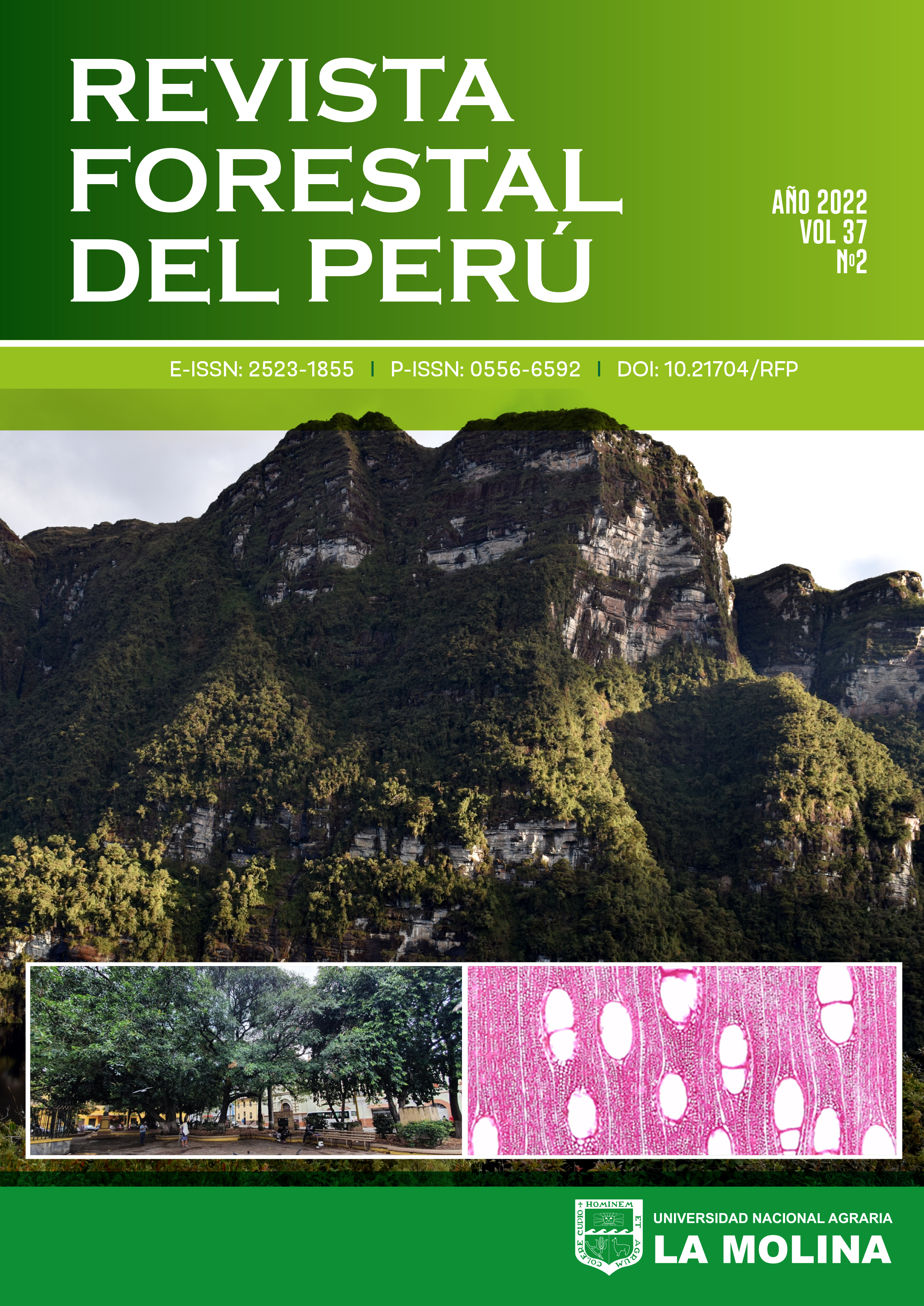Current situation of the tola’s shrubs in San Jose de Aymara, Huancavelica - Peru
DOI:
https://doi.org/10.21704/rfp.v37i2.1951Keywords:
shrubs, tolas, puna, serrania, agroforestry, climate changeAbstract
The native bushes/shrubs are part of the Andean landscape. They are used to protect the ground and improve soil conditions, and in the highlands in the south of the country some of them are used as all year-round firewood, especially during the wet season. This article includes an update of the situation of the "tolas" planted in the Andean community of San Jose de Aymara and the results of a small survey developed in 2020. The visit to the community confirmed that the tolas remain growing, also it was observed that there were various sizes. These shrubs were planted in the community back in 2005, and since then are not produced in the community’s nursery. Currently, Pinus
spp. and Polylepis spp. are the only trees that can be found at the nursery during winter. Therefore, to interpret the survey’s results and analyse the observed behaviour of the tolas in this area, a literature review of the propagation of the tolas Parastrephia quadrangularis and Baccharis tricuneata was carried out. Then, to highlight the benefits and limitations of these native shrubs known as “tolas” a literature review of potential uses in the management of ecosystems, in areas where forestry/agroforestry could work within the context of climate change. Although via surveys a glanced view of the importance, knowledge and uses that the community recognise for these shrubs.
Downloads
References
Abastos, FP. 1993. Composición Química y Digestiva de Forrajes Nativos en Llamas y Ovinos en el Altiplano Desértico. Tesis Ing. Agr. Cochabamba, Bolivia. 85 p.
Aureliano, J. 1992. Propagación sexual del Aliso (Alnus jorullensis H.B.K) en el Callejón de Huay las. Tesis Ing. For. L ima, Per ú. 89 p.
Borel, R. 1990. Especies agrosilvopastoriles para la zona altoandina. Pomata, Perú, Arbolandino. 205 p.
Brack Egg, A. 1986. Ecología de un país complejo. En Gran Geografía del Perú. v. 2. Edit. Manfer Juan Mejía Baca. Barcelona, España.
Brako, L; Zaruchi, J. 1993. Catalogue of the flowering plants and gymnosperms of Peru. Missouri, Estados Unidos de América, Botanical Garden. 1286 p.
Cabrera, AL. 1978. Flora de la provincia de Jujuy. Buenos Aires, Argentina. t. 13, pt. 10, 726 p. (Colección científica del INTA).
CATIE (Centro Agronómico de Investigación y Enseñanza). 2015. Sistemas Agroforestales. Funciones Productivas, Socioeconómicas y Ambientales. Serie Técnica. Informe Técnico 402. Turrialba, Costa Rica. 454 p. Consultado 24 octubre 2022. DOI: http://cipav.org.co/wp-content/uploads/2020/08/sistemas-agro-forestales-funciones-productivas-socioeco-nomicas-y-ambientales.pdf.
Chepstow-lusty, A; Windfield, MO. 2020. Inca agroforestry: Lessons from the past. AMBIO A Journal of the Human Environment. September 2020. Consultado 14 marzo 2021. DOI: https://doi.org/10.1579/0044-7447-29.6.322.
Dourojeanni, MJ. 2020. ¿Es sostenible el aprovechamiento maderero de bosques naturales en el Perú? Revista Forestal del Perú 35(2):94-105. DOI: http://dx.doi.org/10.21704/rfp.v35i2.1577.
Drechsel, J. 2013. Der potentielle Effekt von vera nderten Temperaturregimes auf ausgewa hlte landwirt-schaftlich genutzte Vegetationsformen in den peruanischen Zentralandeneine Modellstudie. Tesis Magister. INCA Project. Dresden, Alemania. 108 p.
ICRAF (International Centre Research Agroforestry). 1994. Annual Report for 1993: 80 – 87. Nairobi, Kenya.
Jost, FP. 2016. Trees in the Andes: Sustainable livelihood strategies for risk reduction. Thesis Doc. Dresden, Alemania. 249 p.
PRONAMACHCS (Proyecto Nacional de Manejo de Cuencas Hidrográficas y Conser-
vación de Suelos, Perú). 1998. Manual de producción de plantas forestales a raíz desnuda en la sierra peruana. Cajamarca, Perú. 137 p. Proyecto “Forestería en microcuencas altoandinas”.
Martínez, E. 2002. Caracterización morfológica y fitosociológica de las especies de thola en el ámbito de la cuenca Titicaca. Puno, Perú, IIPSCQOLLASUYO.
Medina, F. 2011. Monitoring and analysing land use/land cover and their changes using Remote Sensing and GIS in the Achamayo and Shullcas region, Peruvian Andes. Tesis Magister. Dresden, Alemania. 105 p. INCA Project
Montero, S. 2006. Propagación sexual de: Para strephia quadrangularis y Baccharis tricuneata en San José de Aymara – Huancavelica. Tesis Ing. For. L ima, Per ú. 108 p.
Montero, S. 2021. Propagación mediante semilla botánica de Parastrephia quadrangularis y Baccharis tricuneata en San José de Aymara – Huancavelica, Perú. Revista Forestal del Perú 36(2):118-131. DOI: https://doi.org/10.21704/rfp.v36i2.1798.
ONERN. 1984. Inventario y evaluación de los Recursos Naturales de la zona alto andina del Perú – Huancavelica. 367 p.
OSINFOR (Organismo de Supervisión de los Recursos Forestales y de Fauna Silvestre). 2020. OSINFOR en Cifras. Reporte estadístico IV trimestre – 2019. 74 p.
Pérez Mercado, R. 1994. Comportamiento hídrico-fisiológico y fases fenológicas de la Thola. Tesis Ing. Agr. Oruro, Bolivia. 130 p.
Reynel, C; Felipe-Morales, C. 1987. Agroforestería tradicional en los Andes del Perú: un inventario de tecnología y especies para la integración de la vegetación leñosa a la agricultura. Lima, Perú, FAO. 154 p. Proyecto FAO – Holanda/INFOR.
Reynel, C. 1988. Plantas para leña en el sur-oc-cidente de Puno. Puno, Perú, MINAGRI. 165 p. Proyecto Arbolandino-Puno.
Sánchez, PA. 1995. Science in agroforestry. Agroforestry: Science, policy and practice. 5 – 55 pp.
Sánchez-Vega, I; Dillon, MO. 2006. Jalcas. In Moraes, R., Øllgaard, B; Kvist, P; Borchsenius, F; Baslev, H (eds.) Botánica Económica de los Andes Centrales. La Paz, Bolivia. p. 77–90. Consultado 14 de marzo 2021. Disponible en https://www.reserachgate.net/publication/268077864.
SENAMHI (Servicio Nacional de Meteorología e Hidrología del Perú). 2005. Parámetros climáticos de la Estación Acostambo a 3650 m.s.n.m.
Takahashi, L. 2020. El desafío del arquitecto en la protección de los bosques del Perú. Revista Forestal del Perú 35(2):94-105. DOI: ttp://dx-.doi.org/10.21704/rfp.v35i2.1578
Villagran C.; Romo, M. 2003. Etnobotánica del sur de los Andes de la primera región de Chile: un enlace entre las culturas altiplánicas y las quebradas altas del Loa superior (en línea). Revista Antropología Chilena, Chungara (Arica) 35(1):73-124. Consultado el 11 ene 2005. Disponible en http://dx.doi.org/10.4067/S0717-
Weberbauer, A. 1945. El mundo vegetal de los andes peruanos: estudio fitogeográfico. 2 ed. Lima, Perú, Ministerio de Agricultura. 776 p.
Downloads
Published
Issue
Section
License
Copyright (c) 2022 Revista Forestal del Perú

This work is licensed under a Creative Commons Attribution-NonCommercial 4.0 International License.





